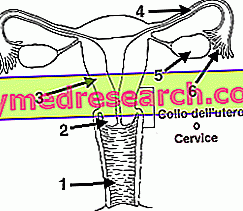Generality
Endometrial or uterine body cancer originates from the glands of the mucosa that lines the cavity of the body of the uterus. This tumor is now the most common of the genital apparatus. However, endometrial cancer mortality is significantly lower than that for ovarian and cervical cancer.
Endometrial cancer occurs mainly in the age group between 55 and 65 years (average age 61 years) and only in 20% of cases before menopause has begun. Instead, it is rare (3-5% of cases) before the fourth decade of life. In recent years it seems that the disease continues to be more frequent in post-menopause, but has become rarer under the age of 55. The incidence varies widely depending on the nations and race; currently, in Italy, around 10 invasive cancers of the endometrium per year per 100, 000 women arise.

1) VAGINA 2) NECK OF THE UTERUS 3) UTERO 4) TUBE OF FALLOPPIO 5) OVAIO 6) FIMBRIE
The uterus is the female reproductive organ. It has a characteristic funnel shape with the neck (cervix) facing downwards. This opening communicates with the vaginal canal which opens outwards with the small lips.
The walls of the uterus are formed by two layers, one external glandular (endometrium) and one inner muscular (myometrium).
Article Index
Risk factors The different forms of endometrial cancer Symptoms Endometrial cancer Tumor spread Symptoms Diagnosis Stage and prognosis TherapySurvival survivalRisk factors
Women at risk for endometrial cancer have some features that often recur:
- obesity;
- late menopause or an early menarche;
- polycystic ovary syndrome (with increased estrogen and cycles without ovulation);
- use, for long periods, of estrogens not associated with progesterone (estrogens have a proliferative stimulus towards the glandular mucosa of the endometrium which, in excessive conditions, can lead to cancer);
- prolonged use (for years) of tamoxifen in patients who have had breast cancer;
- diabetes;
- hypertension;
- nulliparity (not having had children);
- chronic diseases of the liver and biliary tract;
- presence of ovarian tumors that produce estrogen in large quantities;
- Lynch syndrome type II (familial syndrome in which various types of tumors occur, especially in the colon and endometrium).
The most significant risk is however represented by the first four conditions.
Types of endometrial cancer
This tumor can arise at any point in the cavity of the body of the uterus and can occur in two forms: a circumscribed one and a diffuse one.
Circumscribed tumor
The circumscribed form usually appears as a polyp or, more rarely, as an ulceration or as a nodule. The tumor can deeply infiltrate the myometrium (the uterine layer under the endometrium) and thus cause a progressive erosion of the muscle thickness until it reaches the peritoneum.
Diffuse tumors
The diffuse form usually occupies most of the uterine cavity and is usually due to the extension of a circumscribed form, but in some cases it may also be due to a multicentric origin (in several points at the same time) of the tumor. Myometrial infiltration is less frequent in diffuse and / or proliferative than in ulcerative forms.
The uterus usually has an increased volume and a diminished consistency; however, it can also appear quite normal.
Tumor severity
Within endometrial cancer, also called adenocarcinoma because it originates from a glandular component, there are different degrees of differentiation (alteration) of the cells that compose it. The degree of differentiation is very important for the purpose of being able to elaborate a prognosis, therefore also for the purpose of being able to evaluate the most adequate type of therapy.
According to the most used classification, called FIGO, the degrees of endometrial cancer are 3: G1, G2, G3. Clearly, G1 tumors have the best prognosis.
- In G1 grade, adenocarcinoma is formed by glands similar to normal ones, but more tortuous and complex. It must be differentiated, since it tends to look like us, from endometrial polyps, endometrial hyperplasia and chronic inflammation of the endometrium.
- In the G2 grade there is a less marked differentiation (ie the tumor glands look much less like the healthy ones, and are therefore called "atypical").
- In grade G3 the tumor glandular structures are bizarre and sometimes they are not well definable as such. Hemorrhages and areas of cell death are more frequent and the tumor is called, at this stage, undifferentiated adenocarcinoma.



